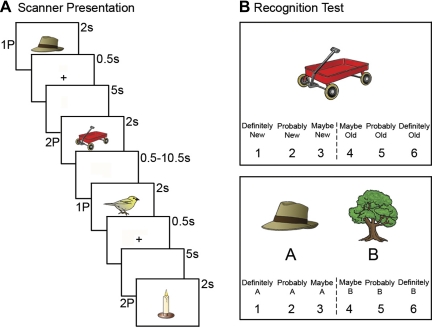Fig. 1.
Experimental design. A: example of the encoding task used in the scanner illustrating the sequential presentation of 4 stimuli in pairs of 2 (1P-2P and 1P-2P). Each stimulus was presented for 2 s. After the 1P stimulus, a plus sign cued the association of the preceding stimulus (1P) with the following stimulus (2P). The plus sign was presented for 0.5 s, followed by a 5-s interitem delay. A jittered intertrial interval lasting 0.5–10.5 s separated each 2P stimulus from the next 1P stimulus. B: example of the postscan recognition test. Subjects were shown 2P stimuli previously viewed during the encoding task as well as novel stimuli, and they were asked to rate their confidence that the picture (e.g., wagon) was new or that it was shown during the scan (old) on a scale from “1, definitely new” to “6, definitely old.” If the target stimulus was included in the encoding task, a follow-up question was provided where subjects were shown 2 choice stimuli, A and B (both of which were previously shown during encoding), and were asked to rate their confidence that the target stimulus was paired with image A (e.g., hat) or B (e.g., tree) on a scale from “1, definitely A” to “6, definitely B.”

